Once a project is approved, it’s likely that the execution will require goods and services outside the purview of the organization managing the work. The process of soliciting bids from third-party vendors and contractors is done through a document called a request for proposal or, more commonly, an RFP.
It is through this channel that project managers collect interested parties and make a decision on who to contract with for the project. The best way to get familiar with this process is by using an RFP template, which allows you to fill in the blanks in order to produce a thorough RFP. We will provide some RFP templates you can use below, but first, let’s better understand what we’re talking about.
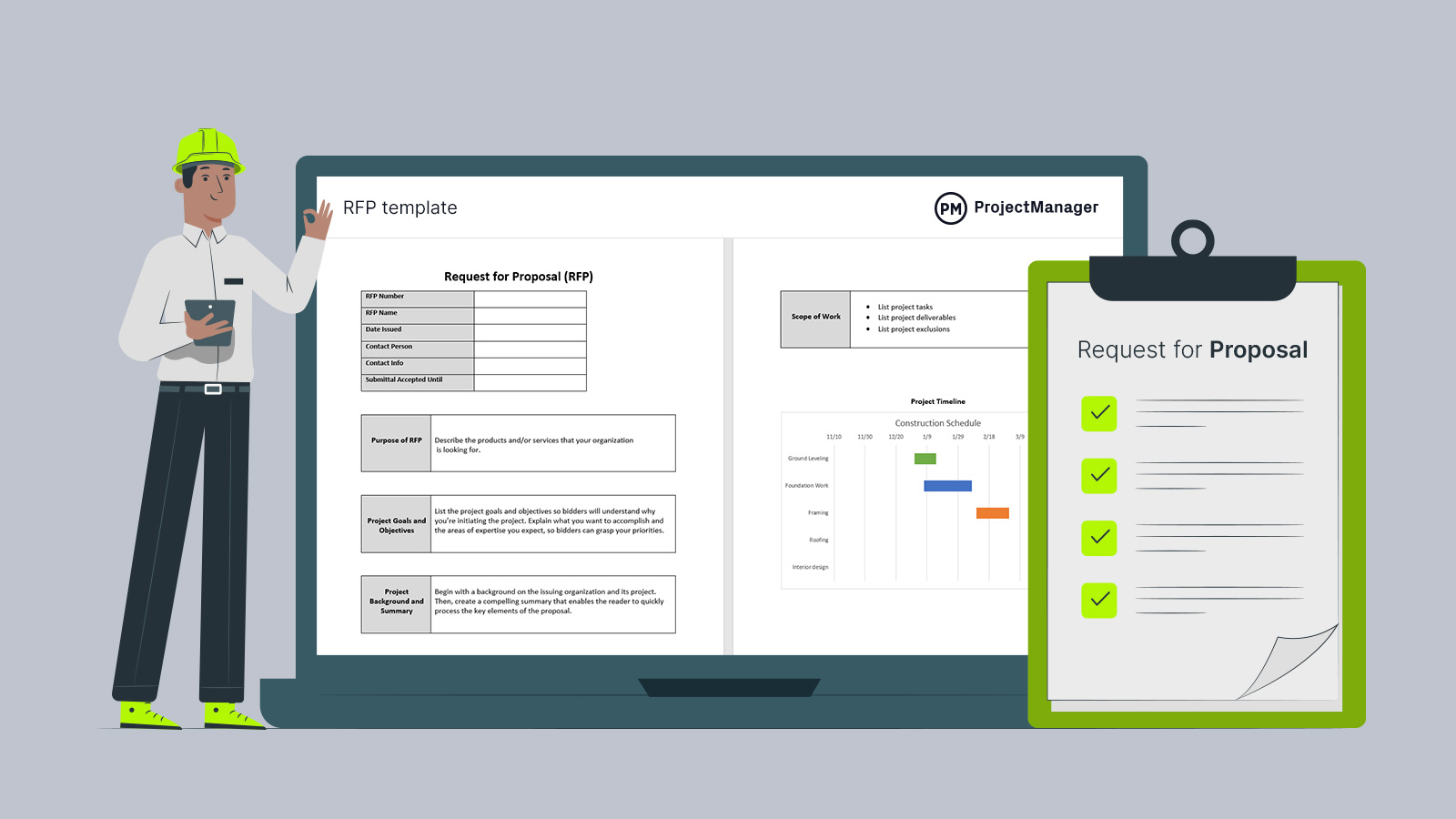
Get your free
RFP Template
Use this free RFP Template for Word to manage your projects better.
What Is a Request for Proposal (RFP)?
A request for proposal (RFP) is a document that’s sent to vendors and contractors that can supply a company’s project with necessary products and services that fall outside of what the soliciting organization can provide internally. The RFP, then, is a document to source that work and allow vendors and contractors to bid for the work.
The RFP provides an overview of the project in order to give the bidding companies a clear description of what is needed and how they can help accomplish those goals. It will explain the process and contract terms to guide bidders. Most organizations conduct business using RFPs, and governments will almost always conduct their business this way.
After sending out multiple RFPs, you will have a selection of interested parties who can deliver the goods and services you require that will best fit your needs, both for the skills they offer and how they meet the demands of your project budget.
RFPs are not only a way to simplify shopping around for vendors and contractors who meet the criteria of your project; they also detail the scope of the work and what the payment for the goods and services will be. Having this clearly laid out in the RFP helps avoid any miscommunications down the line about compensation, delivery dates and more.
A request of proposal is only the first step towards a successful project. Once it starts, you’ll need a robust project management software like ProjectManager to create project schedules, allocate resources, track costs and monitor progress. ProjectManager has a variety of project management tools including Gantt charts, online timesheets, real-time project dashboards, workload balancing chart and much more. Get started for free today.
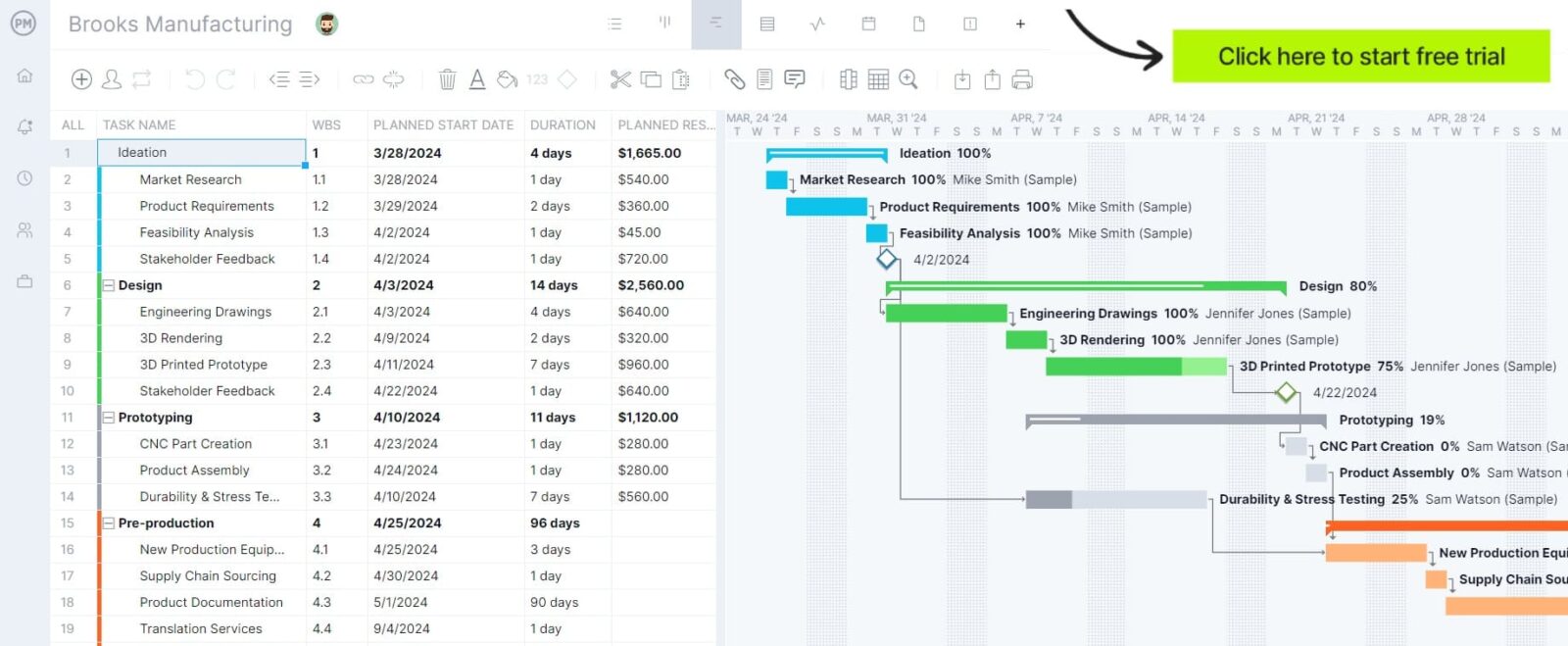
What Should Be Included In a Request for Proposal (RFP)?
Let’s take a closer look at the various sections to include in a request for proposal.
Project Overview
In this section, summarize the project’s objectives, scope and desired outcomes. Determine the key phases of the project including milestones, deadlines or time-sensitive aspects. If there’s a target audience such as an end user or key stakeholders, be sure to describe them in this section as well.
Scope of Work
In an RFP, next comes the scope of work. Here, specify which services or work will be provided, including the operational, functional or technical needs. It should be clear what the vendor is expected to deliver, such as products, services or documents. If there are any elements outside the scope of work, clarify them to avoid scope creep.
Proposal Requirements
In the proposal requirements section, outline vendor information such as the company’s size, location and any relevant experience. Vet them and ensure they have relevant case studies, certifications and previous work experience that applies to the job. Don’t hesitate to ask for references if needed.
Evaluation Criteria
How will the proposals be evaluated? The evaluation criteria section is the place to outline this, including the weight of each factor including price, quality and timeline. If there are non-negotiable requirements such as specific qualifications, highlight them here.
Budget and Pricing
The request for proposal also needs a budget and pricing section. For example, what is the cost structure and is there a set budget that vendors should be following? Vendors should be able to provide a detailed cost breakdown including labor, overhead and materials. This section should also include payment terms that outline how and when a payment will be made.
Timeline
In the RFP’s timeline section, determine the deadline for submitting proposals. There should also be project timeline information that includes the anticipated start and end dates, key milestones and the review approval process. Outline the vendor response time in this section as well, including the expected timeline for reviewing proposals and selecting vendors.
Terms and Conditions
The request for proposal’s terms and conditions section should highlight any confidentiality agreements and data protection requirements. Be sure to include guidelines surrounding dispute resolutions in case anything comes up during the project. Contract term details should also be included such as service-level agreements or warranties.
Submission Instructions
Here, note the needed format for submitting the proposal such as a PDF, Word document, etc. Specify the needed format for submitting the proposal whether it be email, online portal or a physical submission. Should vendors have any questions or need clarification before the submission deadline, let them know how they can ask questions or get more information.
Attachments
Attachments include relevant project documents that can help the vendor understand the project such as design documents, reports, specifications or product descriptions. If needed, include proposal templates or forms that must be completed.
Request for Proposal (RFP) Example
To better illustrate the use of RFPs in project management, let’s look at a request for proposal example we’ve created below. In this case, a property management company is creating a request for proposal to award a landscaping work contract, which consists of improving the outdoor experience for their residents by planting drought-resistant vegetation, irrigation systems, and hardscaping for the property.
Click the image below to download the example.

When to Use a Request for Proposal (RFP)
A request for proposal is a versatile document that helps with procurement and contracting for projects in virtually any industry. Here are some RFP examples, but there are many other possible use cases for them.
- Marketing RFP: When a marketing agency is creating its marketing materials, whether that is a case study or a campaign, they will often employ talent through one of these.
- Branding RFP: Creating a brand for an organization requires guidelines, and the organization will have certain expectations, which are outlined in this type of RFP.
- Design RFP: This RFP targets graphic artists to develop print, web, mobile or other advertisements.
- Website RFP: When you’re building a website, you need to employ web developers and other specific talent related to web design, who will reply to this kind of RFP.
- Government RFP: Any work done for a government agency requires an RFP that will outline the specific requirements associated with that office.
- Nonprofit RFP: When working with a nonprofit organization there are different criteria than with a for-profit business, which will be detailed here.
- Finance RFP: RFPs in finance are often formal questionnaires that investors send to financial services firms to help them choose the right financial partner.
- Construction RFP: Organizations can obtain additional details and better understand how to accomplish their goals through RFPs, ultimately helping them choose the best vendor.
- Procurement RFP: RFPs are often one of the first steps in the procurement process and aid businesses in choosing the vendor that meets their list of criteria. RFPs in procurement often follow a request for information (RFI).
- Real Estate RFP: In real estate, agents put together RFPs on behalf of their tenants to outline important points and economic terms for each deal.
Making a Request for Proposal: RFP Process
There are no set rules for creating an RFP, as they can vary from company to company, industry to industry and for-profit and not-for-profit organizations. However, they do share a common goal and usually, the RFP process will hit these pertinent points.
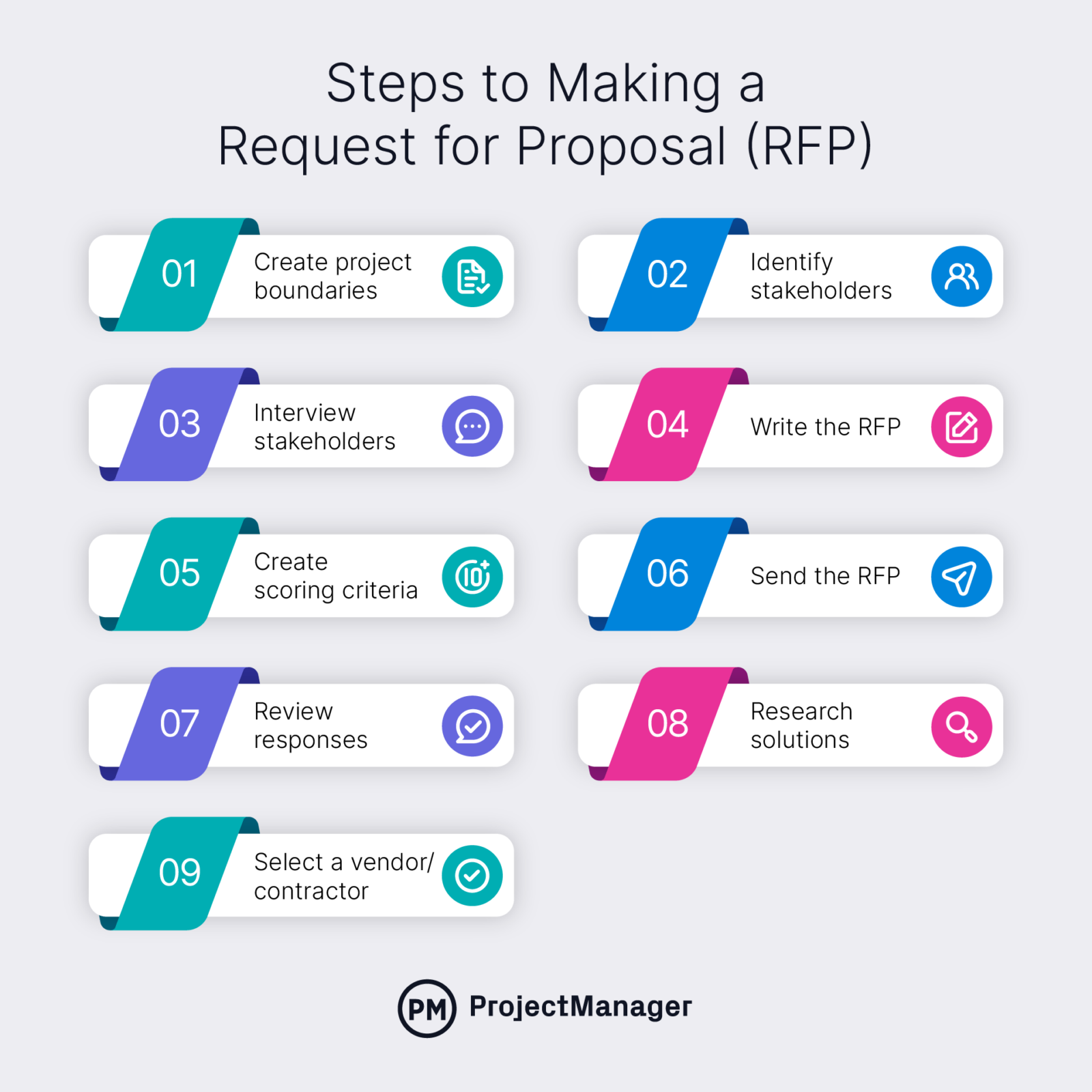
1. Create Project Boundaries
Prior to the pen hitting the paper, speak to the higher-ups in your organization about the constraints for the project, such as what the highest budget they’d approve is, the flexibility of the deadlines, which requirements are a must-have and so forth.
2. Identify Stakeholders
An RFP is a complicated matter that requires a deep knowledge of the project and the organization. Identify key stakeholders and select a representative group that is open to meeting with whomever you assign to oversee the process so they can use them as a soundboard.
3. Interview Stakeholders
Once you have identified the stakeholders, and while you’re in the process of figuring out who can be on call for any questions, also get them to define the project needs. Their answers will inform not only the RFP process but the entire project.
4. Write the RFP
The writing of an RFP can be helped by using an RFP template, which we’ll provide links to below. They are generally structured as follows.
- Organizational background
- Short project description
- Project requirements and objectives
- Project budget
- Milestones and deadlines
- Further info and/or questions
- Contact info and the deadline for submission
5. Create Scoring Criteria
Before you send out the RFP, review it once more, but this time rank the importance of the replies you receive from the vendors and contractors who respond. This is a good method for selecting a smaller group of qualified candidates.
6. Send Out the RFP
Naturally, the whole point of this process is to get it into the hands of prospective vendors and contractors. Therefore, you need to figure out the best place to publish your RFP so that it reaches the right people. It helps to employ consultants to guide you through this phase.
7. Review Responses
After the deadline for submissions, gather all the responses and do a quick read-through to get an idea of the proposed solutions. You can then apply the scoring system you developed earlier.
8. Research
You might get some responses offering a solution that you’re unfamiliar with. It’s important to do the research and see if these might be viable, even if they’re not on your radar. Another part of the research includes doing background work on the vendors and contractors who replied to get a better picture of who you might be contracting into work.
9. Select a Vendor or Contractor
Pick the vendor or contractor who fits your criteria; then do a background check to track their record working in previous projects. This will initiate a negotiation, as a proposal is just that. It may be accepted as-is, or it may require some back and forth. Once everyone is on the same page, sign a contract.
Request for Proposal (RFP) Template
This free RFP template allows you to define what construction contractors will need to include as part of their project proposals when bidding on your project.
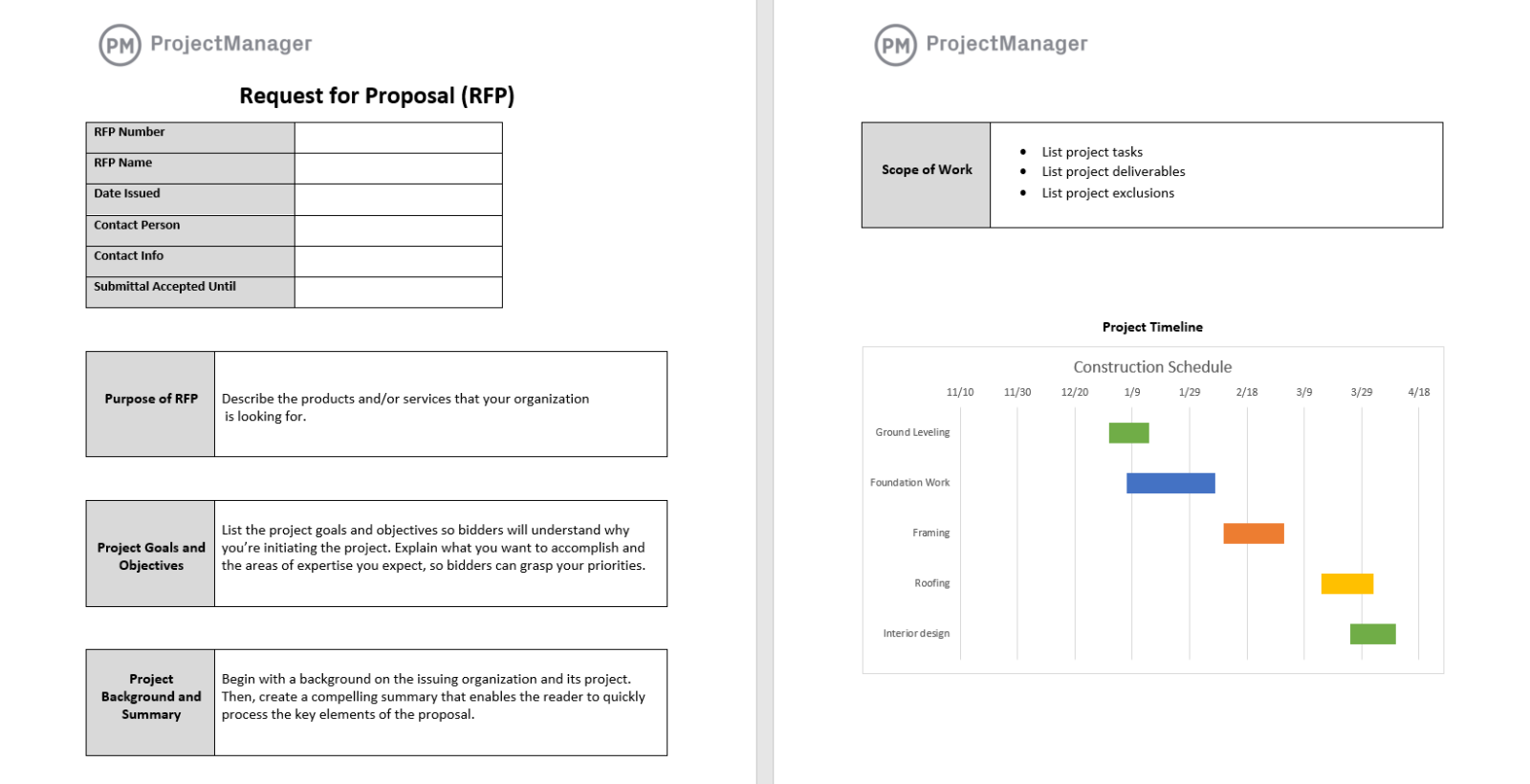
We offer a variety of free construction project management templates for Excel you can use to manage all aspects of your construction project.
What Is the Difference Between an RFP, RFI & an RFQ?
There are so many different types of request forms that it can get a bit confusing to differentiate between them. For instance, there is a request for information (RFI), which is used when a business knows what it wants from a bidder, but requires more detail. RFIs are therefore less lengthy documents because they are concerned more with clarifying information provided by a vendor or contractor.
Another business document that is often confused with an RFP is the request for a quote (RFQ). These documents are, again, less detailed and instead focus solely on how much the vendor or contractor wants for their good or service. The RFQ can also be asking for information on how the vendor or contractor will meet your requirements.
In short, RFIs and RFQs are really subsets of an RFP, which is a higher-level call for proposals to solve a business issue or project need. It is typically far more detailed and formal, with strict procurement rules, including content, timeline, etc. All three documents are often used together, in some combination, or even independently at times.
The Importance of a Request for Proposal (RFP) in Project Management
RFPs are particularly important in the project management space as they help keep project managers organized and help them make crucial business decisions. Each RFP outlines different vendor options complete with details on pricing, steps in the process, contract terms and more.
It is through these RFPs that project managers can sift through the information to determine the best path forward on behalf of their organization. It is up to the project manager to select the RFP that best aligns with the project and its goals to choose the ideal vendor for the project.
RFP project managers are not only critical thinkers and team leaders but they are detail-oriented, patient and strategic in order to act as an advocate for their organization.
RFP is a Project: Try Using Software to Manage the Process
An RFP, even with an RFP template to guide you, is nothing that can be thrown together quickly. It involves research and a thorough breakdown of the project ahead. In fact, it is a project within a project. It makes sense, then, that project management software like ProjectManager can help you as you build your RFP.
Plan your RFP with our interactive Gantt chart, which schedules all your tasks on a timeline. Set milestones on the timeline to break up your work into more manageable segments, such as the delivery of project description, goals, objectives and budget.
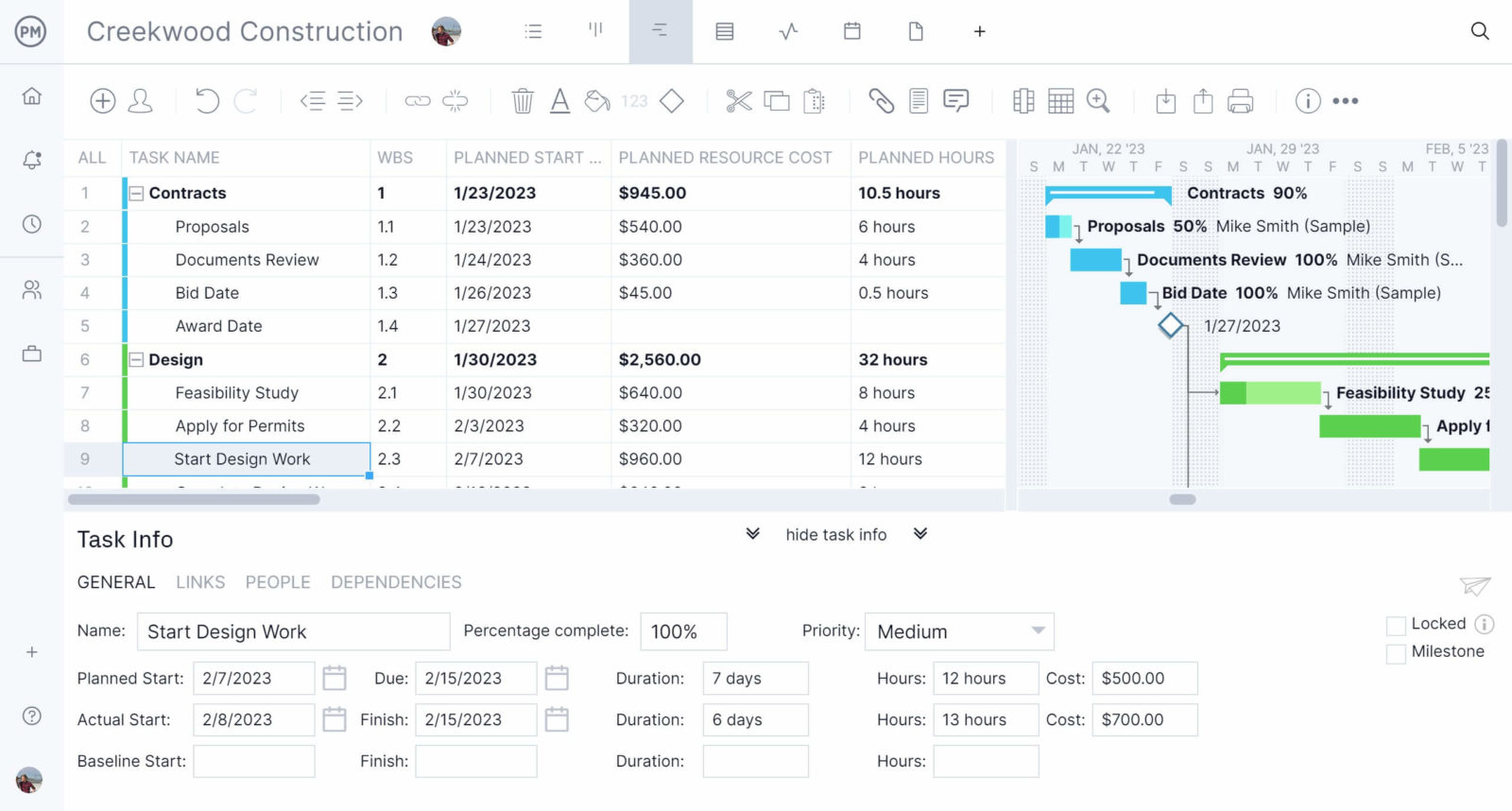
Our kanban boards are a visual tool that shows your workflow and helps you avoid bottlenecks by keeping resources matched with capacity. Take all the steps in the RFP process and make each a kanban card, which has space to describe it, tag it for priority and more.
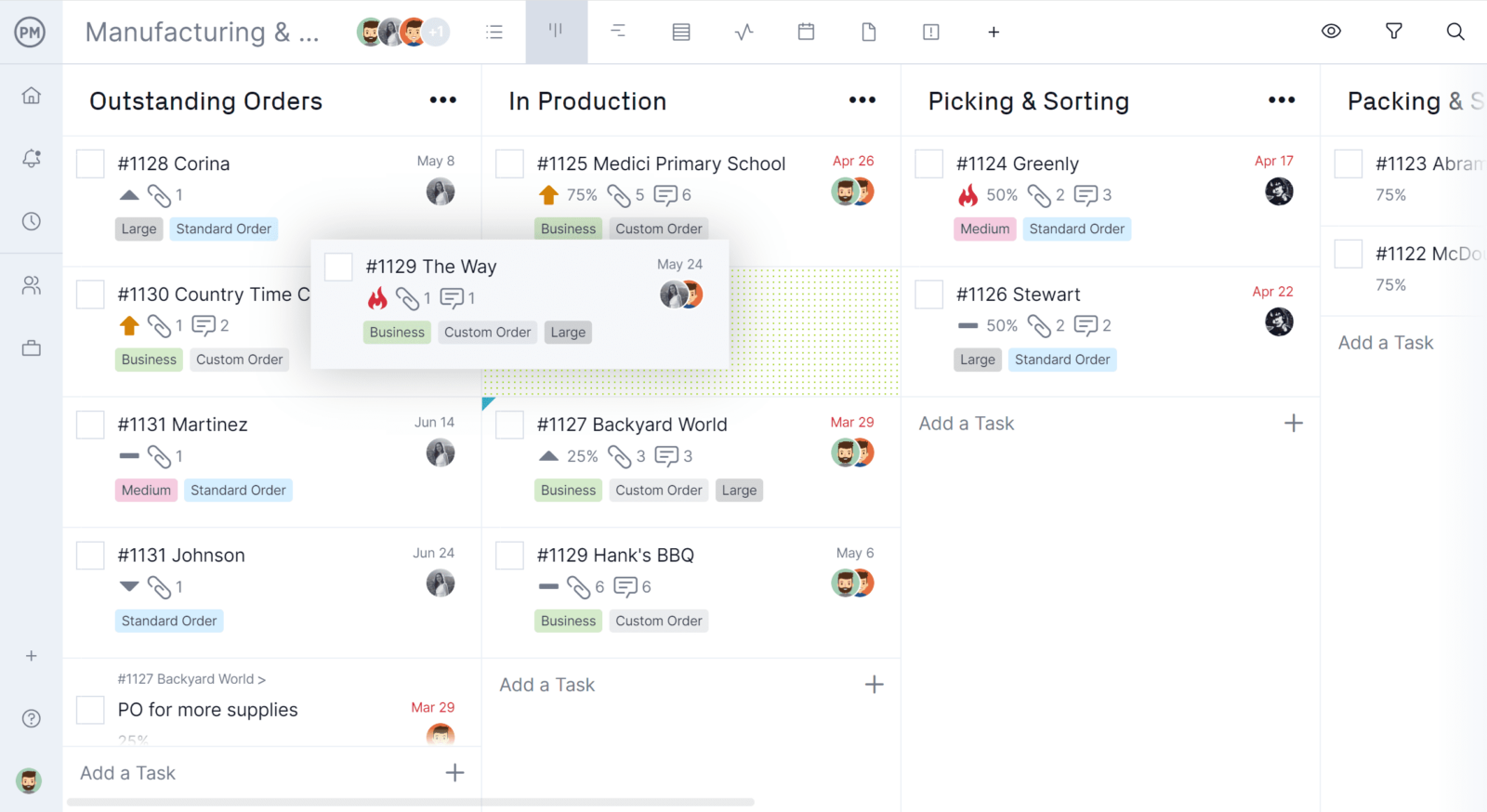
Once assigned, watch as it moves from column to column indicating where in the process it is. Team members can comment at the task level if they have questions and tag other project members to bring them into the conversation as needed. Collaboration helps everyone work more productively.
More RFP Templates
RFP templates come in all shapes and sizes. The simplest are maybe only a few pages, but they can expand to dozens. There are some that have coversheets and flashy presentations, while others are barebones, just-the-facts documents.
What is right for you depends on the project and your organization or maybe just a personal preference. The following are a few sites that offer RFP templates to download. Visit them and see if there’s one that works for you.
Ready to make that RFP a success? Don’t take any chances, use ProjectManager, cloud-based software that helps you work more efficiently. Get the features you need to plan, monitor and report on your work better. Try the tool for free with this 30-day trial.

